A
Auto Express
Guest
Verdict
The Mazda MX-30 looks and feels the part if you want an electric car with a difference. It’s softer and more forgiving than a MINI Electric, but almost as good to drive. The interior feels modern and hi-tech, and every model comes loaded with kit. But while many people will forgive the MINI and Honda e their relatively short driving ranges, it’s harder to justify the Mazda given its position as a larger SUV. Most rivals are focussing on producing long-range rivals, with admittedly larger price tags.
Over the past few years, we’ve seen a flurry of new pure-electric cars from manufacturers with no prior experience in this area of the market. Now it’s the turn of Mazda – a company known for its love of petrol power with high-capacity, naturally aspirated engines, rather than zero-emission city runarounds.
Its first effort is this: the MX-30. It’s a small SUV not dissimilar in design to the brand’s CX-30 petrol and diesel powered alternative. In fact, if you get the tape measure out, you’ll notice it is exactly the same length and width as its sibling, if ever-so-slightly taller. The MX-30 and CX-30 even share the same wheelbase.
The MX-30’s badge tentatively suggests that Mazda’s first electric car has as much in common with the MX-5 sportscar as it does the firm’s crossovers and SUVs. We’ve already driven the MX-30 on European roads, but now we’re finding out if that’s a claim that stands up in the UK.
First impressions suggest that like the MX-5, this is a car that prioritises handling finesse over straight-line speed. Most EVs – including those in this area of the market – benefit from an intense punch of instant torque, and while the MX-30’s response is notable, it doesn’t pin you to your seat like a MINI Electric.
The MX-30 trades on its more playful chassis. The softer suspension allows for a degree of lean, but the result is a compliant ride and a forgiving handling set-up that doesn’t bounce around rougher corners. With an extra 30bhp, it’d surely challenge the MINI for driver fun.
There are three levels for the regenerative braking system, operated via paddles on the steering wheel. While the strongest doesn’t allow for true one-pedal driving like you’ll find in many modern EVs, it’s forceful enough to slow the car in normal driving, and you’ll quickly learn to anticipate its effectiveness – resorting to the left pedal only during less predictable stops.
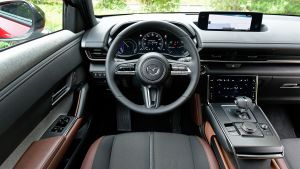
image
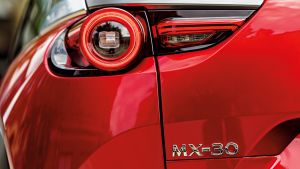
image

image
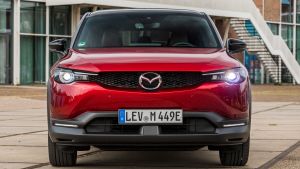
image
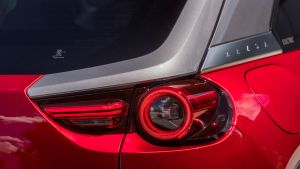
image
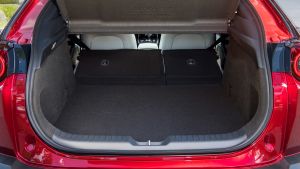
image
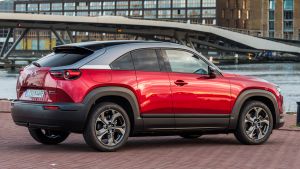
image

image
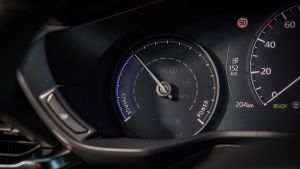
image
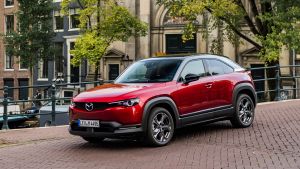
image
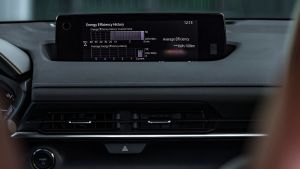
image
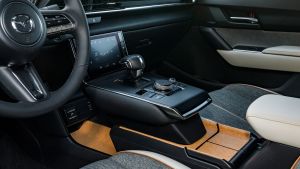
image
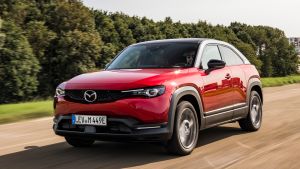
image

image
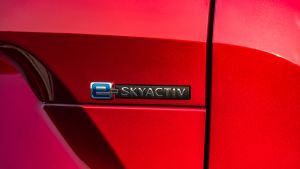
image

image

image
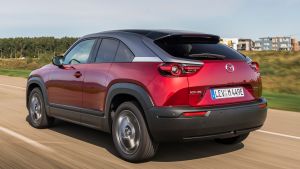
image
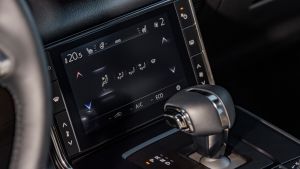
image
Around town the Mazda is easy to drive, with the slightly dulled responses making it feel less frantic than some urban EVs. It’s a shame the rear windows are so small and dark; this does nothing for over-the-shoulder visibility and can make parking a chore.
That tiny glasshouse makes the sitting in the back a bit of pain, too. And despite the lack of a B-pillar – just like the old Mazda RX-8, no less – it’s a challenge to access the rear seats. While a child may be able to squeeze between the rear hinge and the driver’s seat, adults will need to fold the front chair forward before clambering into the back.
And yet the biggest thorn in the MX-30’s side is its electric range. Mazda claims this car’s smaller battery is more environmentally friendly, substantially reducing lifetime CO2 versus a comparatively larger battery alternative. The maker says those looking for greater flexibility should wait for the petrol-electric range-extender model, available later in 2021.
But while plenty of people will scoff at the electric MX-30’s claimed 165-mile urban range, its publicised 124-mile ‘combined’ figure is far more realistic. Many will forgive the compact MINI and Honda e their relatively short driving ranges, but the further up the segments we move into larger cars, the more difficult it is to justify a small range - even if the Mazda is well priced in comparison with rivals using bigger batteries.
Still, 50kW rapid charging is standard (the same as the MINI can manage) – allowing for a 0-80 per cent top-up in 36 minutes. A home wallbox will do the same job in around five hours; Type 2 and three-pin plugs are provided as standard.

image

image

image

image

image

image

image

image

image

image

image

image

image

image

image

image

image

image

image
The Mazda’s kit list is pretty generous, actually. The range kicks off with the SE-L Lux, priced from £25,545 including the government’s plug-in car grant. This version gets 18-inch alloy wheels, LED lights and an 8.8-inch touchscreen, plus Apple CarPlay and Android Auto. It’s this model that represents the best value for money.
Moving up the range, Sport Lux (£27,545) adds privacy glass, piano black and chrome trim, heated seats and keyless entry. GT Sport Tech (£29,845) cars like ours get a sunroof, 12-speaker Bose stereo and a 360-degree parking camera. First Edition models will be available for a limited time, too, combining a number of high-end features including three-tone paint for £27,495.
Sitting up front you’re unlikely to find much cause for concern – especially with regards to quality and functionality. The MX-30 uses sustainable materials throughout, including recycled plastic bottles on the doors and cork for the centre console, giving the crossover an eco-friendly but premium feel. Mazda has installed the climate control system within a small touchscreen on the lower dash, retaining physical buttons for the temperature and fan speed to make the unit easier to use on the move.
Of course, anyone looking at an MX-30 will save a pretty penny when it comes to running costs. There’s no road tax to pay, and every version qualifies for zero Benefit in Kind (BiK) liability – making it an incredibly affordable company car. It’s exempt from the London Congestion Charge, too.
Continue reading...
The Mazda MX-30 looks and feels the part if you want an electric car with a difference. It’s softer and more forgiving than a MINI Electric, but almost as good to drive. The interior feels modern and hi-tech, and every model comes loaded with kit. But while many people will forgive the MINI and Honda e their relatively short driving ranges, it’s harder to justify the Mazda given its position as a larger SUV. Most rivals are focussing on producing long-range rivals, with admittedly larger price tags.
Over the past few years, we’ve seen a flurry of new pure-electric cars from manufacturers with no prior experience in this area of the market. Now it’s the turn of Mazda – a company known for its love of petrol power with high-capacity, naturally aspirated engines, rather than zero-emission city runarounds.
Its first effort is this: the MX-30. It’s a small SUV not dissimilar in design to the brand’s CX-30 petrol and diesel powered alternative. In fact, if you get the tape measure out, you’ll notice it is exactly the same length and width as its sibling, if ever-so-slightly taller. The MX-30 and CX-30 even share the same wheelbase.
- SEE MORE Best electric SUVs to buy now
The MX-30’s badge tentatively suggests that Mazda’s first electric car has as much in common with the MX-5 sportscar as it does the firm’s crossovers and SUVs. We’ve already driven the MX-30 on European roads, but now we’re finding out if that’s a claim that stands up in the UK.
First impressions suggest that like the MX-5, this is a car that prioritises handling finesse over straight-line speed. Most EVs – including those in this area of the market – benefit from an intense punch of instant torque, and while the MX-30’s response is notable, it doesn’t pin you to your seat like a MINI Electric.
The MX-30 trades on its more playful chassis. The softer suspension allows for a degree of lean, but the result is a compliant ride and a forgiving handling set-up that doesn’t bounce around rougher corners. With an extra 30bhp, it’d surely challenge the MINI for driver fun.
There are three levels for the regenerative braking system, operated via paddles on the steering wheel. While the strongest doesn’t allow for true one-pedal driving like you’ll find in many modern EVs, it’s forceful enough to slow the car in normal driving, and you’ll quickly learn to anticipate its effectiveness – resorting to the left pedal only during less predictable stops.

image

image

image

image

image

image

image

image

image

image

image

image

image

image

image

image

image

image

image
Around town the Mazda is easy to drive, with the slightly dulled responses making it feel less frantic than some urban EVs. It’s a shame the rear windows are so small and dark; this does nothing for over-the-shoulder visibility and can make parking a chore.
That tiny glasshouse makes the sitting in the back a bit of pain, too. And despite the lack of a B-pillar – just like the old Mazda RX-8, no less – it’s a challenge to access the rear seats. While a child may be able to squeeze between the rear hinge and the driver’s seat, adults will need to fold the front chair forward before clambering into the back.
And yet the biggest thorn in the MX-30’s side is its electric range. Mazda claims this car’s smaller battery is more environmentally friendly, substantially reducing lifetime CO2 versus a comparatively larger battery alternative. The maker says those looking for greater flexibility should wait for the petrol-electric range-extender model, available later in 2021.
But while plenty of people will scoff at the electric MX-30’s claimed 165-mile urban range, its publicised 124-mile ‘combined’ figure is far more realistic. Many will forgive the compact MINI and Honda e their relatively short driving ranges, but the further up the segments we move into larger cars, the more difficult it is to justify a small range - even if the Mazda is well priced in comparison with rivals using bigger batteries.
Still, 50kW rapid charging is standard (the same as the MINI can manage) – allowing for a 0-80 per cent top-up in 36 minutes. A home wallbox will do the same job in around five hours; Type 2 and three-pin plugs are provided as standard.

image

image

image

image

image

image

image

image

image

image

image

image

image

image

image

image

image

image

image
The Mazda’s kit list is pretty generous, actually. The range kicks off with the SE-L Lux, priced from £25,545 including the government’s plug-in car grant. This version gets 18-inch alloy wheels, LED lights and an 8.8-inch touchscreen, plus Apple CarPlay and Android Auto. It’s this model that represents the best value for money.
Moving up the range, Sport Lux (£27,545) adds privacy glass, piano black and chrome trim, heated seats and keyless entry. GT Sport Tech (£29,845) cars like ours get a sunroof, 12-speaker Bose stereo and a 360-degree parking camera. First Edition models will be available for a limited time, too, combining a number of high-end features including three-tone paint for £27,495.
Sitting up front you’re unlikely to find much cause for concern – especially with regards to quality and functionality. The MX-30 uses sustainable materials throughout, including recycled plastic bottles on the doors and cork for the centre console, giving the crossover an eco-friendly but premium feel. Mazda has installed the climate control system within a small touchscreen on the lower dash, retaining physical buttons for the temperature and fan speed to make the unit easier to use on the move.
Of course, anyone looking at an MX-30 will save a pretty penny when it comes to running costs. There’s no road tax to pay, and every version qualifies for zero Benefit in Kind (BiK) liability – making it an incredibly affordable company car. It’s exempt from the London Congestion Charge, too.
| Model: | Mazda MX-30 GT Sport Tech |
| Price: | £29,845 |
| Engine: | 35.5kWh battery, single electric motor |
| Power/torque: | 143bhp/271Nm |
| Transmission: | Single-speed auto, front-wheel drive |
| 0-62mph; | 9.7 seconds |
| Top speed: | 87mph |
| Range/CO2: | 124 miles, 0g/km |
| On sale: | Now |
Continue reading...
